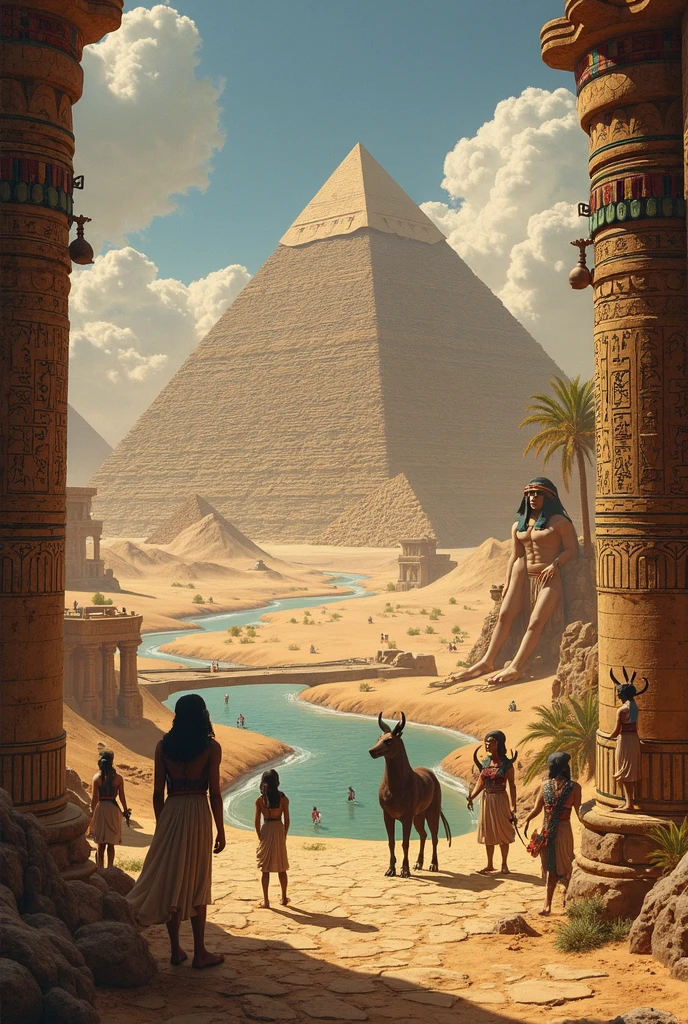Sioux Mythology: The Sacred Beliefs of the Lakota, Dakota, and Nakota
The Sioux mythology is a rich spiritual tradition deeply rooted in the beliefs of the Lakota, Dakota, and Nakota peoples. Central to their cosmology is Wakan Tanka, often referred to as the Great Spirit, who embodies the sacred force that connects all living things. This article explores the profound spiritual concepts, rituals, and symbols that define Sioux beliefs, including the Buffalo, the Sun Dance, and the Sacred Pipe.
Wakan Tanka: The Great Spirit
In Sioux spirituality, Wakan Tanka is the supreme divine force that governs the universe. Unlike a singular deity, Wakan Tanka represents a collective of sacred beings and energies that sustain life. The term translates to “Great Mystery” or “Great Sacredness,” emphasizing the unknowable and infinite nature of the divine.
- Wakan Tanka is not a personified god but a unifying force.
- It encompasses four primary aspects: Inyan (Stone), Maka (Earth), Skan (Sky), and Wi (Sun).
- Prayers and ceremonies are directed toward Wakan Tanka to seek harmony and balance.
The Role of Wakan Tanka in Daily Life
For the Sioux, every action and natural phenomenon is a manifestation of Wakan Tanka. Hunters pray for guidance, warriors seek protection, and healers invoke its power. The concept of Wakan (sacredness) extends to all aspects of existence, reinforcing a deep respect for nature and community.
The Buffalo: A Sacred Provider
The Buffalo holds immense spiritual significance in Sioux mythology. Known as Tatanka, it symbolizes abundance, strength, and survival. The Sioux relied on the buffalo for food, clothing, and tools, but its importance transcends the physical.
| Symbolism | Meaning |
|---|---|
| Strength | Represents endurance and resilience |
| Sacrifice | Gives life to sustain the people |
| Spiritual Connection | Messenger between humans and Wakan Tanka |
The White Buffalo Calf Woman
One of the most revered figures in Sioux mythology is the White Buffalo Calf Woman, a sacred being who brought the Sacred Pipe to the people. Her arrival marked a covenant between Wakan Tanka and the Sioux, teaching them prayers, rituals, and the importance of living in harmony.
The Sun Dance: A Sacred Ceremony
The Sun Dance is one of the most important rituals in Sioux spirituality. This four-day ceremony involves fasting, dancing, and piercing as acts of sacrifice and devotion to Wakan Tanka. Participants seek visions, healing, and communal renewal.
- Purpose: To honor the Creator and renew the world.
- Key Elements: The sacred tree, drumming, and prayer offerings.
- Modern Practice: Still performed today with deep reverence.
Symbolism of the Sun Dance
The dance represents the cycle of life, death, and rebirth. The central pole symbolizes the connection between Earth and Sky, while the dancers embody the suffering and perseverance of the Sioux people. Learn more about its significance from Encyclopedia Britannica.
The Sacred Pipe: Chanunpa
The Sacred Pipe, or Chanunpa, is a central element in Sioux ceremonies. Given by the White Buffalo Calf Woman, it serves as a direct link to Wakan Tanka. Smoking the pipe is a sacred act that seals prayers and agreements.
| Component | Spiritual Meaning |
|---|---|
| Pipe Bowl | Represents the Earth |
| Pipe Stem | Symbolizes the connection to the Sky |
| Tobacco | Offering to the spirits |
Modern-Day Reverence for the Pipe
Today, the Sacred Pipe is used in ceremonies such as weddings, healings, and council meetings. Its use is restricted to those who have earned the right through spiritual dedication. For further reading, visit Native Hope.
Key Figures in Sioux Mythology
Beyond Wakan Tanka, Sioux mythology includes numerous deities, spirits, and heroes. Here are some of the most significant:
- Iktomi – The trickster spider who teaches through mischief.
- Heyoka – Sacred clowns who defy norms to provoke wisdom.
- Wohpe – The goddess of peace and harmony.
Stories and Oral Traditions
Sioux myths are passed down through oral storytelling, preserving history and moral lessons. Explore a collection of these tales at Legends of America.
Descubre más artículos sobre mitología y espiritualidad en nuestra web y síguenos en facebook.com/zatiandrops.
The Vision Quest: Seeking Spiritual Guidance
A cornerstone of Sioux spirituality is the Vision Quest, a solitary journey undertaken to seek wisdom, healing, or a deeper connection with Wakan Tanka. Typically performed by young individuals entering adulthood, this rite involves fasting, prayer, and meditation in a remote location for several days.
- Preparation: Purification through sweat lodge ceremonies (Inipi) precedes the quest.
- Purpose: To receive visions or messages from the spirit world.
- Symbols: Animals, natural elements, or ancestors often appear as guides.
Modern Interpretations of the Vision Quest
Today, the Vision Quest remains a vital practice, though adaptations exist. Some participants incorporate contemporary issues, such as environmental stewardship, into their prayers. The quest reinforces the Sioux belief in personal responsibility and communal harmony.
The Inipi (Sweat Lodge) Ceremony
The Inipi, or sweat lodge, is a purification ritual central to Sioux spirituality. Representing the womb of Maka (Earth), it symbolizes rebirth and cleansing. Participants enter a dome-shaped structure heated by sacred stones, where prayers and songs are offered.
| Element | Significance |
|---|---|
| Sacred Stones | Represent the enduring strength of Inyan (Stone) |
| Water | Symbolizes life and purification |
| Four Rounds | Each round honors a cardinal direction and aspect of Wakan Tanka |
Healing and Community in the Inipi
The Inipi is not only a physical cleanse but also a spiritual and emotional healing space. Elders often lead ceremonies to address community struggles, reinforcing unity and resilience. For a deeper understanding, visit Sweat Lodge Ceremony.
The Role of Animal Spirits in Sioux Beliefs
Animals are revered as messengers and teachers in Sioux mythology. Each creature embodies specific virtues and lessons, guiding humans in their spiritual journeys.
- Wolf (Šungmanitu Tanka): Symbolizes loyalty, intelligence, and family bonds.
- Eagle (Wanbli): Represents courage, vision, and a connection to the divine.
- Bear (Mato): Embodies strength, healing, and introspection.
Animal Totems and Personal Guidance
Many Sioux individuals identify with an animal totem, revealed through dreams or visions. These totems serve as lifelong spiritual guides, influencing decisions and personal growth.
The Star People and Celestial Myths
Sioux cosmology includes fascinating narratives about the Star People, celestial beings believed to have visited Earth. The Pleiades (Seven Sisters) hold particular significance, often associated with creation stories and seasonal cycles.
| Celestial Body | Mythological Role |
|---|---|
| Morning Star (Wichaphi) | Herald of new beginnings and warriors’ protector |
| Moon (Hanwi) | Feminine energy, governing cycles and intuition |
| Milky Way | Pathway for spirits traveling to the afterlife |
The Fallen Star Legend
One popular tale tells of a star that fell to Earth, transforming into the first human. This story underscores the Sioux belief in humanity’s celestial origins and interconnectedness with the cosmos.
Sacred Numbers in Sioux Symbolism
Numbers hold profound meaning in Sioux rituals and mythology, reflecting the natural order and spiritual principles.
- Four: Represents the cardinal directions, seasons, and elements (earth, air, fire, water).
- Seven: Symbolizes the Seven Council Fires (Oceti Šakowin) of the Sioux Nation.
- Twelve: Reflects the lunar cycles and the annual journey of the sun.
Numerology in Ceremonies
These numbers are woven into rituals like the Sun Dance, where four days of dancing mirror the four directions. Such patterns reinforce balance and alignment with Wakan Tanka’s design.
The Ghost Dance: A Movement of Renewal
In the late 19th century, the Ghost Dance emerged as a spiritual movement among the Sioux, promising the return of ancestors and the restoration of their lands. Led by the Paiute prophet Wovoka, it combined Christian influences with traditional Sioux beliefs.
- Core Belief: Dancers would enter a trance, communicating with the spirit world.
- Outcome: Misunderstood by U.S. authorities, it tragically contributed to the Wounded Knee Massacre.
- Legacy: Today, it’s remembered as a symbol of resistance and cultural preservation.
Modern Revivals and Interpretations
Some Sioux communities still practice adapted forms of the Ghost Dance, focusing on its messages of hope and unity. Learn more about its history at History.com.
The Importance of Dreams and Visions
Dreams are considered sacred communications in Sioux culture, offering guidance, warnings, or prophecies. Visionaries (Wicasa Wakan, or holy men) interpret these messages for the community.
| Dream Symbol | Interpretation |
|---|---|
| Thunderbird (Wakinyan) | Divine intervention or impending change |
| Running Water | Emotional or spiritual cleansing |
| Buffalo Herd | Abundance and communal prosperity |
Contemporary Relevance of Dream Teachings
Even today, Sioux families encourage children to share their dreams, fostering a lifelong connection to the spirit world. Elders emphasize that dreams are a bridge between the physical and spiritual realms.
Rituals for the Changing Seasons
Sioux ceremonies align with natural cycles, honoring the Earth’s rhythms. Seasonal rituals ensure balance and gratitude for Maka’s gifts.
- Spring: Planting ceremonies bless seeds and ask for fertile land.
- Summer: The Sun Dance peaks during the solstice.
- Autumn: Harvest celebrations honor the buffalo and crops.
- Winter: Storytelling preserves history during long nights.
The Winter Solstice and Renewal
The longest night of the year is marked by prayers for the sun’s return, symbolizing resilience and the eternal cycle of life. Families gather to share tales of Iktomi and other tricksters, blending lessons with laughter.
Descubre más artículos sobre mitología y espiritualidad en nuestra web y síguenos en facebook.com/zatiandrops.
The Sacred Hoop: Unity and Balance
The Sacred Hoop (Cangleska Wakan) is a foundational symbol in Sioux spirituality, representing the interconnectedness of all life. This circle embodies harmony among the four directions, elements, and stages of human existence—birth, youth, adulthood, and elderhood.
- Symbolism: The unbroken hoop signifies unity, eternity, and the cyclical nature of time.
- Ceremonial Use: Hoops crafted from willow or sacred wood are used in healing rituals.
- Modern Adaptation: The concept inspires environmental activism, emphasizing Earth’s balance.
The Broken Hoop Prophecy
Sioux oral tradition speaks of a prophecy where the Sacred Hoop would shatter due to human discord. Its restoration, foretold by spiritual leaders, symbolizes cultural revival and global healing.
The Role of Women in Sioux Spirituality
Women hold revered roles as life-givers and spiritual anchors in Sioux society. The White Buffalo Calf Woman exemplifies feminine divinity, while earthly women lead ceremonies like the Coming-of-Age Rite for girls.
| Role | Spiritual Significance |
|---|---|
| Keepers of the Fire | Guardians of home and ceremonial hearths |
| Moon Cycle Observances | Honoring Hanwi (Moon) as a feminine force |
| Storytellers | Preservers of oral histories and moral teachings |
The Power of the Double Woman
In myths, the Double Woman (Winyan Nunpa) appears in dreams, bestowing artistic or prophetic gifts. Women who encounter her often become renowned quillworkers or healers.
Warrior Societies and Spiritual Duty
Sioux warriors (Akicita) were not only protectors but also spiritual stewards. Their societies, like the Kit Fox or Strong Heart, blended combat skills with sacred vows to uphold justice.
- Initiation: Warriors underwent vision quests to receive spirit guides.
- Symbols: Eagle feathers marked bravery; coup sticks counted sacred deeds.
- Modern Legacy: Veterans integrate warrior ethos into advocacy for Indigenous rights.
The Horse in Sioux Warfare and Myth
After its introduction by Europeans, the horse (Šuŋkawakan, “Holy Dog”) transformed Sioux life. Mythologically, it became a bridge between earthly and spiritual realms, celebrated in ceremonies like the Horse Dance.
Death and the Spirit Journey
Sioux beliefs about death emphasize continuity rather than an end. The soul embarks on a journey along the Milky Way (Wanáǧi Tačháŋku), guided by ancestors to the Land of the Spirits.
| Funerary Practice | Purpose |
|---|---|
| Scaffold Burials | Elevating the body to release the spirit skyward |
| Spirit Plates | Offerings of food for the soul’s journey |
| Memorial Feasts | Honoring the deceased annually to maintain bonds |
The Mourning Dove’s Message
A Sioux legend tells how the mourning dove’s call reassures the living that departed souls are at peace. Its song is a reminder of love transcending physical existence.
Sacred Sites and Natural Landmarks
Landscapes like the Black Hills (Paha Sapa) are imbued with spiritual power. These sites are living narratives of creation, where rituals and vision quests are performed.
- Bear Butte (Mato Paha): A pilgrimage site for seekers of visions.
- Wind Cave (Oniya Oshoka): Believed to be the origin place of the Buffalo People.
- Missouri River (Wakpa Šičaŋ): A lifeline and sacred boundary in migration stories.
Environmental Advocacy as Sacred Duty
Modern Sioux activists defend these lands against exploitation, viewing conservation as a fulfillment of ancestral covenants with Wakan Tanka.
Language as a Vessel of Spirit
The Sioux language (Lakȟótiyapi, Dakȟótiyapi) is more than communication—it carries prayers, origin stories, and the vibrational essence of creation. Efforts to revitalize the language are central to cultural preservation.
- Sacred Words: Certain phrases are used only in ceremonies, like the Sun Dance invocations.
- Naming Traditions: Names (e.g., Tatanka Iyotake—Sitting Bull) reflect spiritual destinies.
- Orality: Complex verb structures encode teachings about interconnectedness.
The Whispering Wind
Elders teach that the wind (Tate) carries the voices of ancestors when spoken to in the native tongue. Language learners often practice outdoors to absorb this wisdom.
Descubre más artículos sobre mitología y espiritualidad en nuestra web y síguenos en facebook.com/zatiandrops.


